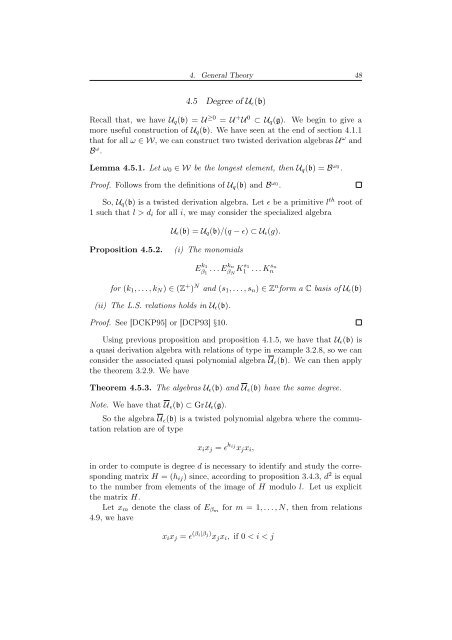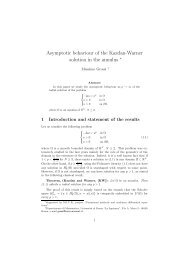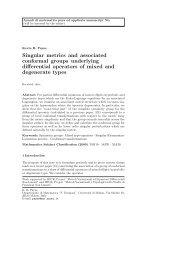Degree of Parabolic Quantum Groups - Dipartimento di Matematica ...
Degree of Parabolic Quantum Groups - Dipartimento di Matematica ...
Degree of Parabolic Quantum Groups - Dipartimento di Matematica ...
You also want an ePaper? Increase the reach of your titles
YUMPU automatically turns print PDFs into web optimized ePapers that Google loves.
4. General Theory 48<br />
4.5 <strong>Degree</strong> <strong>of</strong> Uǫ(b)<br />
Recall that, we have Uq(b) = U ≥0 = U + U 0 ⊂ Uq(g). We begin to give a<br />
more useful construction <strong>of</strong> Uq(b). We have seen at the end <strong>of</strong> section 4.1.1<br />
that for all ω ∈ W, we can construct two twisted derivation algebras U ω and<br />
B ω .<br />
Lemma 4.5.1. Let ω0 ∈ W be the longest element, then Uq(b) = B ω0 .<br />
Pro<strong>of</strong>. Follows from the definitions <strong>of</strong> Uq(b) and B ω0 .<br />
So, Uq(b) is a twisted derivation algebra. Let ǫ be a primitive l th root <strong>of</strong><br />
1 such that l > <strong>di</strong> for all i, we may consider the specialized algebra<br />
Uǫ(b) = Uq(b)/(q − ǫ) ⊂ Uǫ(g).<br />
Proposition 4.5.2. (i) The monomials<br />
E k1 . . .Ekn β1 βN Ks1 1 . . .Ksn n<br />
for (k1, . . .,kN) ∈ (Z + ) N and (s1, . . .,sn) ∈ Z n form a C basis <strong>of</strong> Uǫ(b)<br />
(ii) The L.S. relations holds in Uǫ(b).<br />
Pro<strong>of</strong>. See [DCKP95] or [DCP93] §10.<br />
Using previous proposition and proposition 4.1.5, we have that Uǫ(b) is<br />
a quasi derivation algebra with relations <strong>of</strong> type in example 3.2.8, so we can<br />
consider the associated quasi polynomial algebra Uǫ(b). We can then apply<br />
the theorem 3.2.9. We have<br />
Theorem 4.5.3. The algebras Uǫ(b) and Uǫ(b) have the same degree.<br />
Note. We have that Uǫ(b) ⊂ Gr Uǫ(g).<br />
So the algebra Uǫ(b) is a twisted polynomial algebra where the commutation<br />
relation are <strong>of</strong> type<br />
xixj = ǫ hij xjxi,<br />
in order to compute is degree d is necessary to identify and study the correspon<strong>di</strong>ng<br />
matrix H = (hij) since, accor<strong>di</strong>ng to proposition 3.4.3, d2 is equal<br />
to the number from elements <strong>of</strong> the image <strong>of</strong> H modulo l. Let us explicit<br />
the matrix H.<br />
Let xm denote the class <strong>of</strong> Eβm for m = 1, . . .,N, then from relations<br />
4.9, we have<br />
xixj = ǫ (βi|βj) xjxi, if 0 < i < j








